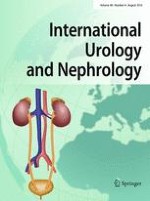Published in:

01-08-2016 | Nephrology - Original Paper
Urinary incontinence and diuretic avoidance among adults with chronic kidney disease
Authors:
Mitul Patel, Kavitha Vellanki, David J. Leehey, Vinod K. Bansal, Linda Brubaker, Robert Flanigan, Julia Koval, Anuradha Wadhwa, Neelam Balasubramanian, Jasmin Sandhu, Holly Kramer
Published in:
International Urology and Nephrology
|
Issue 8/2016
Login to get access
Abstract
Purpose
Diuretics remain an important medication for hypertension management among adults with chronic kidney disease (CKD), but diuretics may also worsen urinary symptoms, especially urinary incontinence (UI). This single-center pilot study examined the prevalence of UI among adults age ≥60 years with CKD using diuretics and assessed diuretic avoidance due to urinary symptoms.
Methods
Patients with non-dialysis-dependent CKD (estimated glomerular filtration rate <60 ml/min/1.73 m2) and diuretic use were recruited from outpatient nephrology clinics. Urinary symptoms and diuretic avoidance were assessed using standardized questionnaires.
Results
The cohort of 44 women and 54 men had a mean age of 71.8 (8.4) years, and urgency-UI, stress-UI and mixed-UI (the presence of both urgency-UI and stress-UI) were reported by 44.9 % (n = 44), 36.7 % (n = 36) and 26.5 % (n = 26), respectively. Nocturia was noted in 68 % (n = 67). Overall, 15.3 % (6 men and 9 women) reported diuretic avoidance. Avoidance of diuretics was 27.3 % (n = 12), 25.5 % (n = 9) and 34.6 % (n = 9) among participants with urgency-UI, stress-UI and mixed-UI, respectively, while only 6.8 % (n = 3) of participants without any UI reported diuretic avoidance. After adjusting for age, sex and diuretic type (loop vs. others), both urgency-UI (odds ratio 5.9 95 % CI 1.5–22.8) and mixed-UI (odds ratio 5.7; 95 % CI 1.6–19.9) were significantly associated with diuretic avoidance compared to participants without urgency-UI, or mixed-UI, respectively. Stress-UI and nocturia were not significantly associated with diuretic avoidance.
Conclusions
UI is common among older adults with CKD receiving diuretics. Patients with urgency-UI are more likely to avoid diuretics.